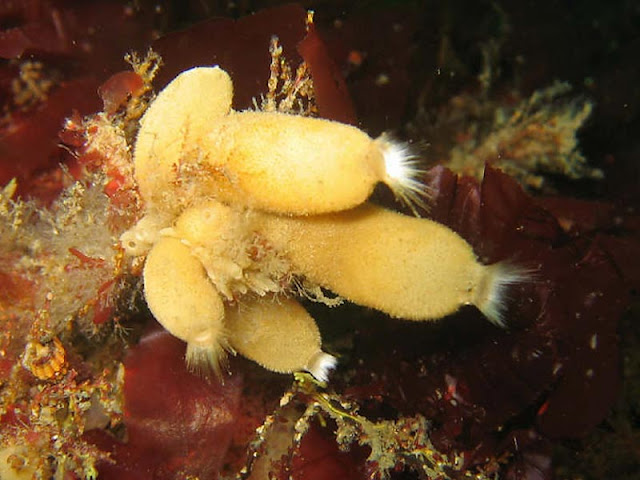
Sponges constitute the Phylum Porifera
(L. porus, pore+ ferre, to bear) which are the simplest type of metazoans. The
term Porifera was coined by Robert Grant and it means “pore bearers” due to the
presence of tiny pores on their body. The study of Porifera or sponges is
called Parazoology. The Phylum Porifera include more than 5000 animal species,
mostly marine, but includes about 150 fresh water inhabitants also. They found
in all seas, wherever there are rocks, shells, submerged timbers, or coral to
provide a suitable substratum. Most sponges prefer relatively shallow water,
but some groups including most glass sponges, live in deep water.
- They are the most primitive metazoans.
- Sponges are multicellular animals lacking specialized tissues and
organs.
- Body grows to various shapes. Most of them are asymmetrical and
some are radially symmetrical.
- They are diploblastic animals [ (Having two germ layers
ectoderm(pinacoderm) and endoderm(chanoderm)].
- They are simple animals having cellular level of organization.
Cells are not organised to tissues or organs.
- The bodies of the sponges are supported by spicules made up of
calcium, silica or sponging fibres.
- The name Porifera means pore bearing animals. The body wall has
numerous pores called ostia. The body encloses large cavity called
spongocoel. Water enters the spongocoel through the ostia and inter
connecting canals present in the body wall. All inter connecting are
collectively called canal system. Water leaves the spongocoel through a
large aperture called osculam. The canals inside the body are linked by
flagellated collar cells or choanocytes. The food particles present in
water current are taken by these cells.
- They lack a metazoan type of digestive system. They rely entirely
on intracellular digestion.
- Mouth, digestive cavity and anus are absent.
- Nervous system and sense organs are also absent.
- Reproduction is both by sexual or asexual means.
- Asexual reproduction takes place by budding or by specialized
cell called gemmules. Gemmules develop into new sponges during favourable
conditions.
- Life cycle includes ciliated free-swimming larvae called
amphiblastula or parenchymula.
- Sponges show greater power of regeration.
🎯Examples of Porifera
- Sycon (Scypha)
- Spongilla (Freshwater sponge)
- Euspongia (Bath sponge)

Classification of Phylum Porifera
Phylum Porifera include three classes, chiefly based on the type of its skeleton. The skeleton of some sponges are utilised for many purposes such as washing, bathing, scrubbing, mopping etc.
1. Class Calcarea
2. Class Hexactinellida
3. Class Demospongia
🎯 Key Points Phylum Porifera (Sponges)
Members of Phylum Porifera are commonly known as sponges. They are generally marine and mostly asymmetrical animals These are primitive multicellular animals and have cellular level of organisation. Sponges have a water transport or canal system. Water enters through minute pores (ostia) in the body wall into a central cavity, spongocoel, from where it goes out through the osculum. This pathway of water transport is helpful in food gathering, respiratory exchange and removal of waste. Choanocytes or collar cells line the spongocoel and the canals. Digestion is intracellular. The body is supported by a skeleton made up of spicules or spongin fibres. Sexes are not separate (hermaphrodite), i.e., eggs and sperms are produced by the same individual. Sponges reproduce asexually by fragmentation and sexually by formation of gametes. Fertilisation is internal and development is indirect having a larval stage which is morphologically distinct from the adult.




